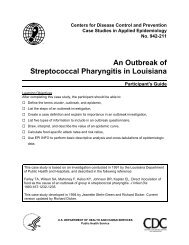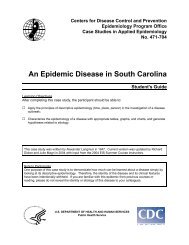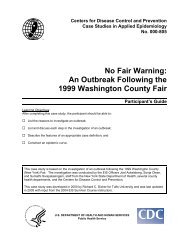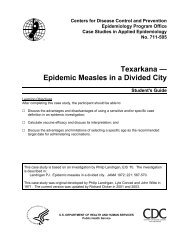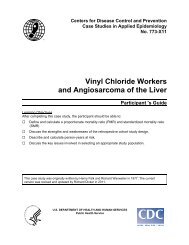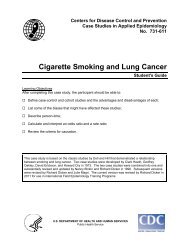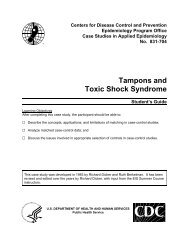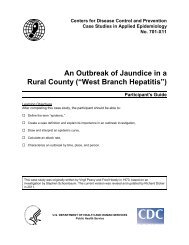Oral Contraceptive Use and Ovarian Cancer - Library
Oral Contraceptive Use and Ovarian Cancer - Library
Oral Contraceptive Use and Ovarian Cancer - Library
- No tags were found...
Create successful ePaper yourself
Turn your PDF publications into a flip-book with our unique Google optimized e-Paper software.
Centers for Disease Control <strong>and</strong> Prevention<br />
Case Studies in Applied Epidemiology<br />
No. 811-X11<br />
Learning Objectives<br />
After completing this case study, the participant should be able to:<br />
<strong>Oral</strong> <strong>Contraceptive</strong> <strong>Use</strong><br />
<strong>and</strong> <strong>Ovarian</strong> <strong>Cancer</strong><br />
Participant's Guide<br />
List the elements needed for Informed Consent in an epidemiologic study<br />
Outline the sequence of an epidemiologic analysis<br />
Discuss the biases of particular concern in case-control studies <strong>and</strong> ways to minimize their<br />
influence<br />
Describe why <strong>and</strong> when to use crude <strong>and</strong> adjusted odds ratios <strong>and</strong> 95% confidence<br />
intervals, <strong>and</strong> how to interpret them<br />
Define <strong>and</strong> recognize effect modification <strong>and</strong> confounding<br />
This case study was developed by Richard Dicker <strong>and</strong> Peter Layde in 1981. Current version updated<br />
by Richard Dicker <strong>and</strong> Julie Magri with input from the EIS Summer Course instructors.<br />
U.S. DEPARTMENT OF HEALTH AND HUMAN SERVICES<br />
Public Health Service
CDC-EIS: OCs <strong>and</strong> <strong>Ovarian</strong> <strong>Cancer</strong> (811-X11) - Participant’s Guide page 2<br />
Part I<br />
In 1980, ovarian cancer ranked as the fourth<br />
leading cause of cancer mortality among women<br />
in the United States. An estimated 18,000 new<br />
cases <strong>and</strong> more than 11,000 attributable deaths<br />
occurred among American women that year.<br />
Several studies had noted an increased risk of<br />
ovarian cancer among women of low parity<br />
(parity = number of liveborn children a woman<br />
has delivered), suggesting that pregnancy exerts<br />
a protective effect. By preventing pregnancy,<br />
oral contraceptives (OCs) might be expected to<br />
increase the risk of ovarian cancer. On the other<br />
h<strong>and</strong>, by simulating pregnancy through<br />
suppression of pituitary gonadotropin release<br />
<strong>and</strong> inhibition of ovulation, OCs might be<br />
expected to protect against the subsequent<br />
development of ovarian cancer. Because by<br />
1980 OCs had been used by more than 40<br />
million women in the United States, the public<br />
health impact of an association in either direction<br />
could be substantial.<br />
To study the relationship between oral<br />
contraceptive use <strong>and</strong> ovarian cancer (as well as<br />
breast <strong>and</strong> endometrial cancer), CDC initiated a<br />
case-control study — the <strong>Cancer</strong> <strong>and</strong> Steroid<br />
Hormone (CASH) Study — in 1980. Casepatients<br />
were enrolled through eight regional<br />
cancer registries participating in the Surveillance,<br />
Epidemiology, <strong>and</strong> End Results (SEER) program<br />
of the National <strong>Cancer</strong> Institute.<br />
Question 1a: Which investigations need to be reviewed by an institutional review board? Does this<br />
investigation need to be reviewed?
CDC-EIS: OCs <strong>and</strong> <strong>Ovarian</strong> <strong>Cancer</strong> (811-X11) - Participant’s Guide page 3<br />
Question 1b: What elements need to be included in an Informed Consent form for participants? Draft<br />
as homework an informed consent form for this study.<br />
As the investigators planned this study, they discussed a variety of methods to minimize potential biases.<br />
Question 2: What types of bias are of particular concern in this case-control study? What steps might<br />
you take to minimize these potential biases?
CDC-EIS: OCs <strong>and</strong> <strong>Ovarian</strong> <strong>Cancer</strong> (811-X11) - Participant’s Guide page 4<br />
As the investigators began to consider what data<br />
to collect with their questionnaire, they began to<br />
lay out the analyses they wanted to conduct.<br />
They did so by sketching out “table shells” —<br />
frequency distributions <strong>and</strong> two-way tables that<br />
contain no data but otherwise include<br />
appropriate titles, labels, measures <strong>and</strong> statistics<br />
to be calculated. The tables followed a logical<br />
sequence from the simple (descriptive<br />
epidemiology) to the more complex (analytic<br />
epidemiology) that is often used when results are<br />
presented in a manuscript or oral presentation.<br />
Question 3:<br />
List, in logical sequential order, the table shells you might use to describe <strong>and</strong> analyze<br />
the CASH study data. You do not need to draw the actual tables.
CDC-EIS: OCs <strong>and</strong> <strong>Ovarian</strong> <strong>Cancer</strong> (811-X11) - Participant’s Guide page 5<br />
Part II<br />
The study design included several features to<br />
minimize selection <strong>and</strong> information bias.<br />
Ascertainment bias of disease status — a type of<br />
selection bias — was minimized by attempting to<br />
enroll as cases all women ages 20-54 years with<br />
newly diagnosed, histologically confirmed,<br />
primary ovarian cancer who resided in one of the<br />
eight geographic areas covered by the cancer<br />
registries. Controls were women ages 20-54<br />
years selected r<strong>and</strong>omly using telephone<br />
numbers from the same geographic areas.<br />
Because 93% of U.S. households had<br />
telephones, virtually all women residing in the<br />
same areas as the cases were eligible to be<br />
controls. (Interestingly, all the women enrolled<br />
with ovarian cancer had telephones.)<br />
To minimize interviewer bias, CDC investigators<br />
conducted group sessions to train interviewers in<br />
the administration of the pretested st<strong>and</strong>ard<br />
questionnaire. The same interviewers <strong>and</strong><br />
questionnaires were used for both cases <strong>and</strong><br />
controls. Neither cases nor controls were told of<br />
the specific a priori hypotheses to be tested by<br />
the study. Recall bias of oral contraceptive<br />
exposure was minimized by showing participants<br />
a book with photographs of all OC preparations<br />
ever marketed in the United States <strong>and</strong> by using<br />
a calendar to relate contraceptive <strong>and</strong><br />
reproductive histories to other life events.<br />
The primary purpose of the CASH study was to<br />
measure <strong>and</strong> test the association between OC<br />
use <strong>and</strong> three types of reproductive cancer —<br />
breast cancer, endometrial cancer, <strong>and</strong> ovarian<br />
cancer. Enrollment of subjects into the study<br />
began in December 1980. During the first 10<br />
months of the study, 179 women with ovarian<br />
cancer were enrolled, as well as larger numbers<br />
of women with endometrial or breast cancer.<br />
During the same period, 1,872 controls were<br />
enrolled to equal the number of subjects with<br />
breast cancer. The same control group was<br />
used for the ovarian cancer analysis; however,<br />
the investigators excluded 226 women with no<br />
ovaries at the time of interview <strong>and</strong> four controls<br />
whose OC use was unknown, leaving 1,642<br />
women to serve as controls. The distribution of<br />
exposure to OCs among cases <strong>and</strong> controls is<br />
shown in Table 1.<br />
Table 1. Ever-use of oral contraceptives among ovarian cancer cases <strong>and</strong> controls, <strong>Cancer</strong> <strong>and</strong> Steroid<br />
Hormone Study, 1980-1981<br />
CASE-CONTROL STATUS<br />
Case Control Total<br />
USE OF OCs<br />
Ever a = 93 b = 959 H 1 = 1052<br />
Never c = 86 d = 683 H 0 = 769<br />
Total V 1 = 179 V 0 = 1642 T = 1821
CDC-EIS: OCs <strong>and</strong> <strong>Ovarian</strong> <strong>Cancer</strong> (811-X11) - Participant’s Guide page 6<br />
Question 4: From these data, can you calculate the risk of ovarian cancer among oral contraceptive<br />
users? Why or why not?<br />
Question 5: Describe the rationale behind using the odds ratio as an estimate of the risk ratio. When<br />
is the odds ratio not an appropriate estimate of the risk ratio?
CDC-EIS: OCs <strong>and</strong> <strong>Ovarian</strong> <strong>Cancer</strong> (811-X11) - Participant’s Guide page 7<br />
The investigators used the data in Table 1 <strong>and</strong><br />
the formulas shown below to calculate an odds<br />
ratio <strong>and</strong> 95% test-based confidence limits.<br />
They also calculated a Mantel-Haenszel Chi as a<br />
test of statistical significance to evaluate the<br />
likelihood that any difference between the<br />
observed (calculated) OR <strong>and</strong> the OR under the<br />
null hypothesis could be due to chance.<br />
Measure Formula Calculation from Table 1<br />
Odds Ratio (OR)<br />
ad<br />
(93)(683)<br />
OR =<br />
= 0.77<br />
bc<br />
(959)(86)<br />
Expected Value of Cell ‘a’<br />
(E(a))<br />
H 1V<br />
E(a)=<br />
T<br />
1<br />
(1052)(179)<br />
= 103.41<br />
1821<br />
Mantel-Haenszel (MH)<br />
Variance<br />
H 1 H 0V<br />
1V<br />
MH variance=<br />
2<br />
T (T -1)<br />
0<br />
(1052)(769)(179)(1642)<br />
= 39.40<br />
2<br />
(1821 ) (1821-1)<br />
Mantel-Haenszel Chi*<br />
a - E(a)<br />
93 -103.41<br />
X MH =<br />
= -1.66<br />
MH variance<br />
39.40<br />
Test-based Confidence<br />
Limits<br />
(Note: Z values for 2-sided<br />
confidence limits are:<br />
90% = 1.645,<br />
95% = 1.96,<br />
99% = 2.58.)<br />
(1-(Z/<br />
X MH ))<br />
LOWER CL= OR<br />
(1 X ))<br />
UPPER CL = OR<br />
+(Z/ MH<br />
0.77<br />
(1(1.96 / 1.66))<br />
= 0.57<br />
(1<br />
0. (1.96 / 1.66<br />
77<br />
)) 1.05<br />
* The chi is the square root of the more commonly used chi-square. The Mantel-Haenszel chi with one<br />
degree of freedom (X MH ) is equivalent to a Z-score <strong>and</strong> can be used to find the 2-tailed p-value from a<br />
table of areas in two tails of the st<strong>and</strong>ard normal curve. In this case, p = 0.097.
CDC-EIS: OCs <strong>and</strong> <strong>Ovarian</strong> <strong>Cancer</strong> (811-X11) - Participant’s Guide page 8<br />
Question 6a: What is the null hypothesis in this study?<br />
Question 6b: What special information does the odds ratio give that you do not get from Chi square<br />
<strong>and</strong> p value? What additional information do you get from the p value <strong>and</strong> Chi square? From a<br />
confidence interval?<br />
Question 7:<br />
How might you describe <strong>and</strong> interpret these results?<br />
In many epidemiologic studies, age is a confounding factor.<br />
Question 8: What is confounding? Under what circumstances would age be a confounder in this<br />
study?
CDC-EIS: OCs <strong>and</strong> <strong>Ovarian</strong> <strong>Cancer</strong> (811-X11) - Participant’s Guide page 9<br />
Part III<br />
In the analysis of use of oral contraceptives <strong>and</strong><br />
ovarian cancer, age was related both to OC use<br />
<strong>and</strong> to case-control status. (OC users were<br />
younger than never-users; case-patients were<br />
younger than controls.) Therefore, the<br />
investigators decided to stratify the data by age<br />
<strong>and</strong> calculate stratum-specific <strong>and</strong>, if<br />
appropriate, summary statistics of the stratified<br />
data. The Mantel-Haenszel (MH) procedure is a<br />
popular method for calculating a summary odds<br />
ratio <strong>and</strong> test of significance for stratified data.<br />
Question 9:<br />
What is stratification? Why stratify data? How do you decide on which variables to<br />
stratify?<br />
Question 10: What is effect modification? How do you look for it?
CDC-EIS: OCs <strong>and</strong> <strong>Ovarian</strong> <strong>Cancer</strong> (811-X11) - Participant’s Guide page 10<br />
Table 2. Ever-use of oral contraceptives <strong>and</strong> risk of ovarian cancer, stratified by age, <strong>Cancer</strong> <strong>and</strong> Steroid<br />
Hormone Study, 1980-1981<br />
Ages 20-39 years<br />
Ever user<br />
Case<br />
46<br />
Control<br />
285<br />
Total<br />
H 1 = 331<br />
OR = 0.69<br />
Expected(a) = 48.73<br />
MH variance = 6.66<br />
Never user 12 51 H 0 = 63<br />
MH Chi = -1.06<br />
95% CLs = 0.34, 1.38<br />
Total V 1 = 58 V 0 = 336 T = 394<br />
Ages 40-49 years<br />
Case Control Total OR = _____<br />
Ever user 30 463 H 1 = 493<br />
Expected(a) = _____<br />
MH variance = 13.39<br />
Never user 30 301 H 0 = 331 MH Chi = _____<br />
Total V 1 = 60 V 0 = 764 T = 824<br />
95% CLs = 0.38, 1.10<br />
Ages 50-54 years<br />
Ever user<br />
Case<br />
17<br />
Control<br />
211<br />
Total<br />
H 1 = 228<br />
OR = 0.61<br />
Expected(a) = 23.06<br />
MH variance = 12.91<br />
Never user 44 331 H 0 = 375<br />
MH Chi = -1.69<br />
95% CLs = 0.34, 1.08<br />
Total V 1 = 61 V 0 = 542 T = 603<br />
Question 11a:<br />
Using the data in Table 2, calculate the odds ratio for the 40- to 49-year age stratum.<br />
Question 11b:<br />
Using the data in Table 2, calculate the expected value of cell A for the 40- to 49-year<br />
age stratum.<br />
Question 11c:<br />
Using the data in Table 2, calculate the Mantel-Haenszel chi for the 40- to 49-year age<br />
stratum.
CDC-EIS: OCs <strong>and</strong> <strong>Ovarian</strong> <strong>Cancer</strong> (811-X11) - Participant’s Guide page 11<br />
The investigators had been taught to look for effect modification before looking for confounding.<br />
Question 12: Do you think age is an effect modifier of the oral contraceptive <strong>and</strong> ovarian cancer<br />
association?<br />
The investigators concluded that age was not an<br />
effect modifier. They therefore decided to<br />
evaluate for confounding by calculating an odds<br />
ratio adjusted for age, also called a summary<br />
odds ratio or Mantel-Haenszel odds ratio, using<br />
the following formula:<br />
ORMH =<br />
(ad / T)<br />
(bc / T)<br />
They calculated a Mantel-Haenszel chi of -2.56,<br />
from which they found a p-value. Finally, they<br />
calculated a 95% confidence interval of 0.45 to<br />
0.92.<br />
Question 13a: Using the stratified data in Table 2, calculate the summary odds ratio adjusted for age.<br />
Question 13b:<br />
Based on the Mantel-Haenszel chi of -2.56 <strong>and</strong> the attached table of the st<strong>and</strong>ard<br />
normal curve, determine the 2-tailed p-value.
CDC-EIS: OCs <strong>and</strong> <strong>Ovarian</strong> <strong>Cancer</strong> (811-X11) - Participant’s Guide page 12<br />
AREAS IN TWO TAILS OF THE STANDARD NORMAL CURVE<br />
Z 0.00 0.01 0.02 0.03 0.04 0.05 0.06 0.07 0.08 0.09<br />
0.0 1.000 0.992 0.984 0.976 0.968 0.060 0.952 0.944 0.936 0.928<br />
0.1 0.920 0.912 0.904 0.897 0.889 0.881 0.873 0.865 0.857 0.849<br />
0.2 0.841 0.834 0.826 0.818 0.810 0.803 0.795 0.787 0.779 0.772<br />
0.3 0.764 0.757 0.749 0.741 0.734 0.726 0.719 0.711 0.704 0.697<br />
0.4 0.689 0.682 0.674 0.667 0.660 0.653 0.646 0.638 0.631 0.624<br />
0.5 0.617 0.610 0.603 0.596 0.589 0.582 0.575 0.569 0.562 0.555<br />
0.6 0.549 0.542 0.535 0.529 0.522 0.516 0.509 0.503 0.497 0.490<br />
0.7 0.484 0.478 0.472 0.465 0.459 0.453 0.447 0.441 0.435 0.430<br />
0.8 0.424 0.418 0.412 0.407 0.401 0.395 0.390 0.384 0.379 0.373<br />
0.9 0.368 0.363 0.358 0.352 0.347 0.342 0.337 0.332 0.327 0.322<br />
1.0 0.317 0.312 0.308 0.303 0.298 0.294 0.289 0.285 0.280 0.276<br />
1.1 0.271 0.267 0.263 0.258 0.254 0.250 0.246 0.242 0.238 0.234<br />
1.2 0.230 0.226 0.222 0.219 0.215 0.211 0.208 0.204 0.201 0.197<br />
1.3 0.194 0.190 0.187 0.184 0.180 0.177 0.174 0.171 0.168 0.165<br />
1.4 0.162 0.159 0.156 0.153 0.150 0.147 0.144 0.142 0.139 0.136<br />
1.5 0.134 0.131 0.129 0.126 0.124 0.121 0.119 0.116 0.114 0.112<br />
1.6 0.110 0.107 0.105 0.103 0.101 0.099 0.097 0.095 0.093 0.091<br />
1.7 0.089 0.087 0.085 0.084 0.082 0.080 0.078 0.077 0.075 0.073<br />
1.8 0.072 0.070 0.069 0.067 0.066 0.064 0.063 0.061 0.060 0.059<br />
1.9 0.057 0.056 0.055 0.054 0.052 0.051 0.050 0.049 0.048* 0.047<br />
2.0 0.046 0.044 0.043 0.042 0.041 0.040 0.039 0.038 0.038 0.037<br />
2.1 0.036 0.035 0.034 0.033 0.032 0.032 0.031 0.030 0.029 0.029<br />
2.2 0.028 0.027 0.026 0.026 0.025 0.024 0.024 0.023 0.023 0.022<br />
2.3 0.021 0.021 0.020 0.020 0.019 0.019 0.018 0.018 0.017 0.017<br />
2.4 0.016 0.016 0.016 0.015 0.015 0.014 0.014 0.014 0.013 0.013<br />
2.5 0.012 0.012 0.012 0.011 0.011 0.011 0.010 0.010 0.010 0.010<br />
2.6 0.009 0.009 0.009 0.009 0.008 0.008 0.008 0.008 0.007 0.007<br />
2.7 0.007 0.007 0.007 0.006 0.006 0.006 0.006 0.006 0.005 0.005<br />
2.8 0.005 0.005 0.005 0.005 0.005 0.004 0.004 0.004 0.004 0.004<br />
2.9 0.004 0.004 0.004 0.003 0.003 0.003 0.003 0.003 0.003 0.003<br />
3.0 0.003 0.003 0.003 0.002 0.002 0.002 0.002 0.002 0.002 0.002<br />
3.1 0.002 0.002 0.002 0.002 0.002 0.002 0.002 0.002 0.001 0.001<br />
3.2 0.001 0.001 0.001 0.001 0.001 0.001 0.001 0.001 0.001 0.001<br />
3.3 0.001 0.001 0.001 0.001 0.001 0.001 0.001 0.001 0.001 0.001<br />
3.4 0.001 0.001 0.001 0.001 0.001 0.001 0.001 0.001 0.001 0.0005<br />
3.5 0.0005 0.0004 0.0004 0.0004 0.0004 0.0004 0.0004 0.0004 0.0003 0.0003<br />
3.6 0.0003 0.0003 0.0003 0.0003 0.0003 0.0003 0.0003 0.0002 0.0002 0.0002<br />
3.7 0.0002 0.0002 0.0002 0.0002 0.0002 0.0002 0.0002 0.0002 0.0002 0.0002<br />
3.8 0.0001 0.0001 0.0001 0.0001 0.0001 0.0001 0.0001 0.0001 0.0001 0.0001<br />
3.9
CDC-EIS: OCs <strong>and</strong> <strong>Ovarian</strong> <strong>Cancer</strong> (811-X11) - Participant’s Guide page 13<br />
Question 14: Summarize <strong>and</strong> interpret these results, including the measure of association, the p-value<br />
In terms of the null hypothesis <strong>and</strong> statistical significance, <strong>and</strong> the confidence interval.<br />
Question 15: How does one assess whether confounding is present? Do you think age is a<br />
confounding variable in this analysis of the association between OC use <strong>and</strong> ovarian<br />
cancer?<br />
Question 16: What are the other ways of eliminating confounding in a study?
CDC-EIS: OCs <strong>and</strong> <strong>Ovarian</strong> <strong>Cancer</strong> (811-X11) - Participant’s Guide page 14<br />
In the introduction to this case study, pregnancy<br />
was described as apparently protective against<br />
ovarian cancer. The investigators were<br />
interested in seeing whether the association<br />
between OC use <strong>and</strong> ovarian cancer differed for<br />
women of different parity. Table 3 shows<br />
parity-specific data.<br />
Table 3. Ever-use of oral contraceptives <strong>and</strong> risk of ovarian cancer, by parity*, CASH Study, 1980-1981<br />
Age-adjusted odds ratios<br />
Parity <strong>Use</strong> of OCs # Case-patients # Controls (95% confidence intervals)<br />
0 Ever user 20 67 0.3 (0.1-0.8)<br />
Never user 25 80<br />
1-2 Ever user 42 369 0.8 (0.4-1.5)<br />
Never user 26 199<br />
3 Ever user 30 520 0.7 (0.4-1.2)<br />
Never user 35 400<br />
* Excludes seven controls (four never-users <strong>and</strong> three ever-users) <strong>and</strong> one case (ever-user) with unknown<br />
parity.<br />
Question 17: Is there any evidence for effect modification in the data presented in Table 3?
CDC-EIS: OCs <strong>and</strong> <strong>Ovarian</strong> <strong>Cancer</strong> (811-X11) - Participant’s Guide page 15<br />
Part IV - CONCLUSION<br />
In their published report, the investigators wrote<br />
the following about the possible effect<br />
modification by parity:<br />
"Parity appeared to be an effect modifier of the<br />
association between oral contraceptive use <strong>and</strong><br />
the risk of ovarian cancer... [Table 3]. Among<br />
nulliparous women, the age-st<strong>and</strong>ardized odds<br />
ratio was 0.3 (95% confidence interval: 0.1-0.8).<br />
Among parous women, however, the odds ratios<br />
were closer to, but still less than, 1.0....It<br />
is possible, therefore, that oral contraceptives<br />
are most protective for women not already<br />
protected by pregnancy."<br />
Although this case study deals with the data<br />
collected over the first 10 months (phase 1) of<br />
the study, an additional 19 months of data<br />
(phase 2) were collected <strong>and</strong> analyzed<br />
subsequently. The following table summarizes<br />
the apparent role of parity as an effect modifier in<br />
the two phases of the study.<br />
Table 4. Age-adjusted odds ratios (aOR) <strong>and</strong> 95% confidence intervals for the association of oral<br />
contraceptive use <strong>and</strong> ovarian cancer, by parity <strong>and</strong> phase of study, CASH Study, 1980-1982<br />
Phase 1 Phase 2 Total<br />
Parity (months 1-10) (months 11-29) (months 1-29)<br />
aOR (95% CI) aOR (95% CI) aOR (95% CI)<br />
0 0.3 (0.1-0.8) 0.7 (0.5-1.2) 0.7 (0.4-1.0)<br />
1-2 0.8 (0.4-1.5) 0.5 (0.3-0.7) 0.5 (0.4-0.8)<br />
3 0.7 (0.4-1.2) 0.5 (0.4-0.8) 0.6 (0.4-0.8)<br />
Total 0.6 (0.4-0.9) 0.5 (0.4-0.7) 0.6 (0.5-0.7)<br />
On the basis of the full study results, it appeared<br />
that the effect of oral contraceptives on ovarian<br />
cancer was not substantially different for<br />
nulliparous women <strong>and</strong> for parous women.<br />
Although there were no published studies of oral<br />
contraceptives <strong>and</strong> ovarian cancer when this<br />
study was launched, there were several by the<br />
time this study was published. Almost all<br />
showed an apparently protective effect of oral<br />
contraceptives on ovarian cancer.<br />
Question 18:<br />
What are the public health <strong>and</strong>/or policy implications of the apparently protective effect<br />
of oral contraceptives on ovarian cancer?
CDC-EIS: OCs <strong>and</strong> <strong>Ovarian</strong> <strong>Cancer</strong> (811-X11) - Participant’s Guide page 16<br />
References — CASH Study<br />
1. Centers for Disease Control. <strong>Oral</strong> contraceptive use <strong>and</strong> the risk of ovarian cancer: the Centers for<br />
Disease Control <strong>Cancer</strong> <strong>and</strong> Steroid Hormone Study. JAMA 1983;249:1596–1599.<br />
2. Centers for Disease Control. The reduction in risk of ovarian cancer associated with oral<br />
contraceptive use: the <strong>Cancer</strong> <strong>and</strong> Steroid Hormone Study of the Centers for Disease Control <strong>and</strong> the<br />
National Institute of Child Health <strong>and</strong> Human Development. N Engl J Med 1987;316:650–655.<br />
References - Data Analysis, Confounding, Effect Modification<br />
3. Dicker RC. Analyzing <strong>and</strong> Interpreting Data. In: Gregg MB. Field Epidemiology, 2 nd edition. New<br />
York: Oxford University Press, 2002.<br />
4. Rothman KJ. Epidemiology: an introduction. New York: Oxford University Press, 2002.<br />
Recent Review of <strong>Oral</strong> <strong>Contraceptive</strong>s <strong>and</strong> <strong>Ovarian</strong> <strong>Cancer</strong><br />
5. Collaborative Group on Epidemiologic Studies of <strong>Ovarian</strong> <strong>Cancer</strong>. <strong>Ovarian</strong> cancer <strong>and</strong> oral<br />
contraceptives: collaborative reanalysis of data from 45 epidemiological studies including 23,257<br />
women with ovarian cancer <strong>and</strong> 87,303 controls. Lancet 2008; 371:303–314.<br />
6. Editorial. The case for preventing ovarian cancer. Lancet 2008: 371:275.




